How to clear clogged pipes at home: the best cleaning products and methods
Removing blockages in pipes on your own at home is not as difficult a task as it seems at first glance.To do this, you can try using both traditional methods and specialized chemicals.
The most effective ways to get rid of blockages will be discussed in our material.
The content of the article:
Determining the location of the blockage
A clogged pipe is a fairly common problem, and if you encounter it, you should not panic and look for the phone number of a plumber. Very often you can handle it yourself, saving time and money.
Before cleaning pipes, it is important to understand where exactly the blockage has formed. This directly affects the choice of method to solve the problem.
To determine the approximate location of the blockage, open the water and see how it “disappears”:
- The water is receding very slowly – most likely, the plug is more than a meter away from the drain. In case of such a problem, the best way is to use a special metal cable.
- Water drops to a certain level, and then everything remains unchanged - the blockage is located in the area from the siphon to the first turn. In this case, it will be enough to use either traditional methods or chemical means.
- The liquid doesn't go away at all – in 90% of cases the siphon is clogged with fatty deposits. The best option to deal with contamination is to manually clean the pipeline.
These are the most common ways to identify where the problem is.
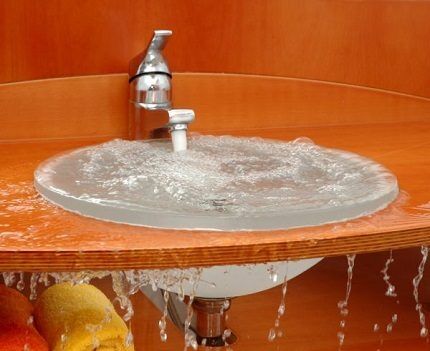
Once you have found out exactly where the blockage has formed, you can begin to remove it.
Popular folk methods
For liquidation blockage in the pipeline improvised means work well. If the problem is caused by the accumulation of fat, then you can try to free the drain from the plug with plain water.
In the case of steel pipes, boiling water works well with fatty deposits - you need to pour it for 20 minutes. For plastic plumbing, hot water is used, but not more than 70 °C.
Running water under strong pressure will help you check whether the problem has been resolved or not.
Method number 1 - baking soda
Sodium carbonate or baking soda, which is familiar to all of us, will help to cope with the blockage of fat deposits in the pipes. It is better if it is domestically produced, since imported analogues are not very effective.
First you need to pour 200 g of baking soda into the drain hole. Next, add 200 ml of vinegar and close the hole tightly. The reaction between the substances will effectively dissolve the grease, removing the blockage. After waiting 10-15 minutes, open hot water under high pressure for a couple of minutes.
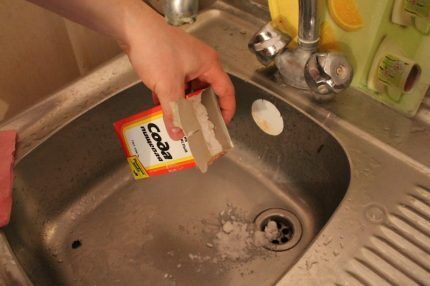
This method is effective only in cases of “fresh” blockages.If they are already old, you will have to use more caustic substances.
Method No. 2 - caustic soda
In the fight against old or severe pollution, you can use a more caustic agent - caustic soda, which can be purchased at any hardware hypermarket.
Take a large metal bucket and put 2-3 kg of caustic soda into it with a plastic scoop. Pour the substance into 12 liters of cold water. Stir the component for 30 minutes. Be as careful as possible so that the solution does not come into contact with your skin. It is necessary that the soda dissolves completely.
Place the bucket on the fire and heat the mixture to 70 °C. It is important not to overexpose the solution, otherwise it will lose its effectiveness. In addition, extremely hot liquid can damage pipes.
Slowly pour half the mixture down the drain and leave for 2 hours. After the specified time, pour out the remaining mixture and wait again for 2 hours. Rinse the drain pipes thoroughly with hot running water.
As housewives note in reviews, caustic soda allows you to cope with even severe blockages the first time. The main thing is to adhere to the proportions and wait the specified time.

Gel caustic soda is more gentle. You can also purchase it at hardware stores. The cost of gel soda is slightly higher than regular soda. And in terms of efficiency, they are practically not inferior to each other.
To clean the pipeline, take 100 ml of the component, pour it into the hole, and then add 250 ml of hot water. Wait 2 hours, then rinse the pipes thoroughly with hot running water.
Method number 3 - soda, vinegar and chlorine
Vinegar, soda and chlorine will help deal with severe stains. All these substances will probably be found in the bins of any housewife. The latter component is not entirely harmless to people, but it allows you to effectively deal not only with fatty deposits, but also with limescale deposits in the water supply.
First of all, remove the water from the sink - excess liquid will reduce the effectiveness of the product. Pour 50 g of soda ash and baking soda into the drain. After 30 minutes, pour in 150 ml of vinegar and 150 ml of chlorine.
Be sure to plug the hole tightly to avoid the appearance of pungent and unpleasant odors in the room. After 30 minutes, open the warm water and leave it for 40 minutes.
Method number 4 - coarse salt
If the problem occurs in cast iron pipes, then coarse salt and boiling water will help deal with it. You can use vinegar essence as a “reagent”, but finding it now is quite problematic.

To begin, pour 300 g of coarse table salt into the drain hole. Add 2 liters of boiling water, 100 ml of 70% vinegar, wait 30 minutes and check the result. Don't worry if you didn't succeed the first time, you may have to repeat the procedure several times.
Method No. 5 – citric acid
Citric acid works great for removing lime deposits in pipes. It has repeatedly proven its effectiveness. Housewives note that the product allows you to cope with the problem even the first time.
First, pour 100 g of citric acid into the drain hole and fill the component with 250 ml of boiling water, and after 20 minutes open the hot water.
Instead of citric acid, use the juice of fresh lemons. Take 100 ml of it and pour it inside the drain. Leave the product for 1 hour and then run running water.
We also recommend reading our other article, where we talked in detail about how to clean a toilet from limescale. Read more - read Further.
Method number 6 - salt and soda
To dissolve the fat plug, use soda and salt. Take 300 g of each component, mix and dissolve in hot water - you need to get a highly concentrated solution. It is important to achieve complete dissolution of the components.
Pour the mixture down the drain and wait 15 minutes and turn on the water briefly. If you cannot solve the problem the first time, perform the procedure again. Only this time, add an additional 15-20 ml of vinegar to the finished composition.
Method No. 7 - Alka-tabletsSeltzer»
Instead of soda and salt, you can use effervescent tablets "Alka-Seltzer" They have repeatedly proven their effectiveness.
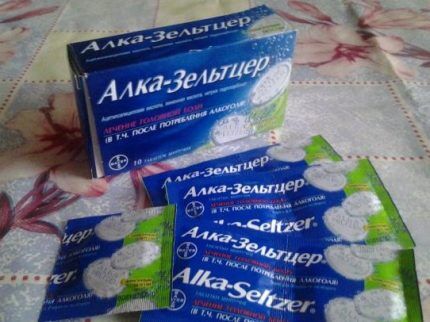
To remove the plug you will need to take 2 tablets and place them in the drain. Pour the tablets with a glass of vinegar and 50 ml of water. Leave everything for a couple of minutes and then rinse with hot water.
Please note that Alka-tabletsSeltzer"Sold in regular pharmacies. They are affordable and available without a prescription.
Method No. 8 - washing powder
To combat light stains and prevent blockages, housewives use washing powder.Agree, it will definitely be found in every home.
To combat blockages, it is important to use granular, rather than liquid, laundry detergent. Only the first option will help to effectively solve the problem.
It is taken in the amount of 2 measuring spoons and poured into the drain. Next, turn on hot running water for 5 minutes. After this time, the plug should disappear.
Let's turn to chemicals
If you don’t have time to experiment with folk remedies, then you can use specialized mixtures that are sold in any supermarket, in the household chemicals department. They are affordable and highly effective.
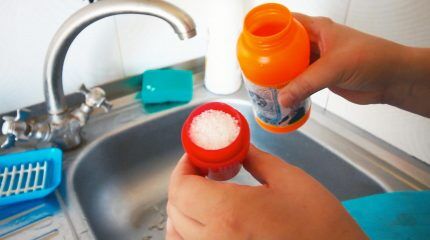
Let's look at the most popular chemicals used by housewives to remove blockages.
Mole - an affordable solution that is well suited for combating household pollution. Pour 200-250 g into the drain and leave for 2 hours. For old plugs, the liquid can be left overnight.
After the specified time, supply water with strong pressure. If the plug cannot be removed immediately, use the product again.
Debouche – a universal liquid for eliminating mechanical and grease blockages. Directions for use: pour 500 ml of liquid into the drain and leave for 3 hours.
For severe contamination, use twice as much product, and the validity period increases to 10-12 hours. After use Debouche Be sure to rinse the pipes thoroughly with water.
Pothan – a solution for removing any types of blockages in cast iron and plastic pipes. First you need to lower the water level in the drain by 5 cm.Next, pour in 100 ml of the product and 100 ml of boiling water. After 5 minutes, warm water is supplied to the drain.
Mister Muscle – a popular powder for eliminating fatty plugs. It penetrates into the most difficult places and, due to its special composition, removes not only clogs, but also harmful bacteria and unpleasant odors. According to the manufacturer, Mr. Muscle copes with the problem in just 5-10 minutes.
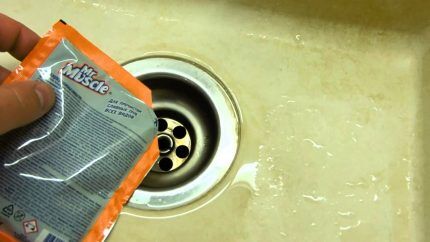
Floop – a cleaner that dissolves fatty, organic and hair plugs. The product is quite caustic, so when working with it, be sure to equip yourself with protective clothing, a respirator and rubber gloves.
Adding Floop into the drain hole, it is important to avoid getting it on plumbing fixtures, as well as on exposed parts of the body or clothing. The product is poured with hot water and left for the time specified in the instructions. Then the drain is washed generously with cold water.
Tiret Turbo – a universal solvent, produced in the form of gel and granules. In the first case, it is poured into the drain and left for 5-10 minutes. Using the granular version, it is first poured into the drain, and then 500 ml of hot water is added and left for at least 10 minutes.
It is prohibited to use the latter remedy for longer than the time specified in the instructions. The active substances included in its composition can cause destruction of pipe walls.
There is an article on our website where we examined in detail the best chemicals for cleaning sewer pipes. Read more - read Further.
Radical solutions to the problem
When the blockage cannot be eliminated using folk remedies and chemicals, you should try to deal with it using mechanical methods.
Option No. 1 – vacuum cleaner
You can use a vacuum cleaner to remove clogs. However, the device must have the function blowing. If you are the owner of such equipment, then first wrap the end of the device hose with a loose rag. It is very important to fix it well.
Press the hose firmly against the drain hole and turn on the vacuum cleaner to maximum. A powerful stream of air will push out the plug formed in the pipe.
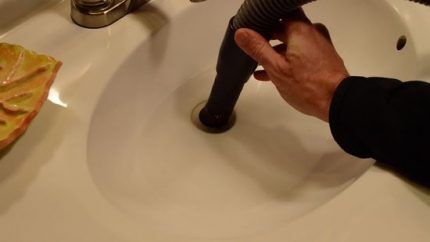
Using a vacuum cleaner is effective when the problem is no more than 1 meter from the drain hole.
Option No. 2 – plunger
To bleed the drain, use a plunger, which can be manual or mechanical. This device is sure to be found in every home. It helps create strong pressure inside the pipe, causing the blockage to break up or pump deeper.
While pumping, move the plunger back and forth without lifting the bowl from the drain. Do several approaches, and then remove the plunger and evaluate the effectiveness of the work. If the liquid drains slowly, you will have to repeat everything all over again.
Before working with a plunger, it is advisable to lubricate its edges with grease or Vaseline. This will ensure tighter contact with the sink.
Option No. 3 - plumbing cable
When a plug has formed on the bends of pipes or far away in communications, a plumbing cable is used. It can be used to hook and pull out a clog or clear it out.
The process of cleaning pipes with a cable begins with dismantling the siphon.Do not try to work the cable directly through the plumbing drain hole. Only by removing the siphon will you have free access to the sewer system.
After installing the cable in the pipe, begin to screw it clockwise, trying to slowly push it forward. Act smoothly and gradually, avoiding sudden movements.
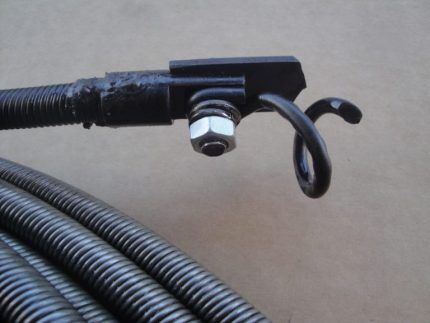
When you encounter resistance, turn the device until it continues to move. After this, you can put the siphon in place and flush the system.
Not everyone has a plumbing cable, but if you want, you can buy it at any plumbing store.
Read about the types of plumbing cables for cleaning sewers in this material.
In addition, you can build this device with your own hands from a plastic bottle and scrap materials.
The instructions are as follows:
- Cover the bottle from top to bottom with strips of tape to form a spiral.
- Draw lines along the border of the adhesive tape with a colored marker.
- Cut the bottle along the marks you made.
- Be sure to leave the bottom - it will act as a handle.
- Make small cuts along the resulting spiral.
- Insert a homemade cable into the drain and push it through, slowly holding it by the “handle”. Due to the notches, debris will cling to it, this way it will be possible to overcome the traffic jam.
This device is only suitable for plugs that are not too far from the siphon.
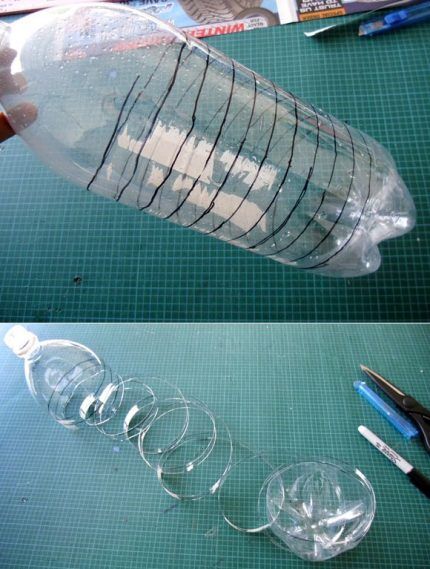
Used for deep blockages steel wire with a diameter of 5-6 mm.One end of it is bent with a hook.
Option No. 4 - disassembling and cleaning the siphon
As was said at the beginning of the article, in 90% of cases the water does not pass beyond the sink due to a clogged siphon.
The cleaning procedure is as follows:
- Spread an unnecessary rag on the floor that absorbs water well. It should be directly under the siphon.
- Place a basin under the sink into which the liquid will subsequently be drained.
- Unscrew the lock nut that secures the siphon tube.
- Remove the siphon. Remove all dirt from it (this is convenient to do with a brush), and then rinse thoroughly under running water.
- Pour a solution of soda and vinegar into the pipe connected to the sewer. When the reaction is complete, pour in an additional 150 ml of vinegar. Repeat this procedure several times.
- After 15-20 minutes, pour several liters of hot water into the pipe and wait 5 minutes.
- Reinstall the siphon and tighten the lock nut.
As a rule, if you follow the instructions given, you will be able to deal with the blockage the first time.
Preventing blockages
The most common cause of clogged drains is grease. It gradually accumulates on the walls of pipes after washing dishes, especially if you wash them in cold water or use a low-quality detergent.
The best prevention is to install grease trap. It is a small structure with two sections that is attached to the sink. The principle of its operation is that first, water with particles of dirt and grease enters the first section of the device, where the liquid is cleaned of debris.
In the second section of the structure, water is cleared of fat and only after that it enters the sewer pipes, which ensures trouble-free operation of the water supply system.
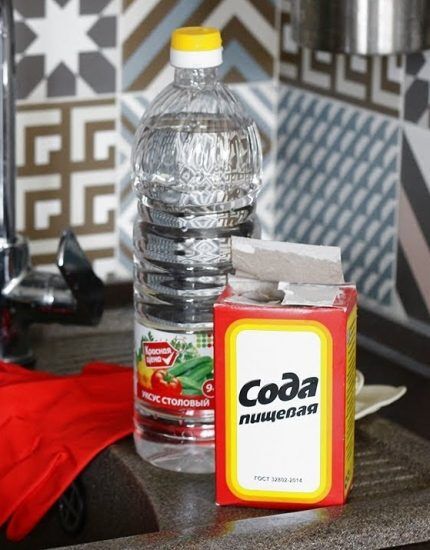
Preventing blockages also involves a number of other measures. Before washing, remove any particles of food stuck to the dishes. It is important to avoid any leftover food going down the drain. By sticking to the pipes, they subsequently become the cause of all sewerage problems.
Also, do not pour fat remaining after cooking down the drain - it must be disposed of separately, otherwise problems with blockages cannot be avoided.
Make it a rule not to throw hair from a comb, paper, or various objects into the toilet. Additionally, install a special protective mesh on the drain.
Once every 2 weeks, turn on the hot water at full pressure for 1-2 hours. Also, use a plunger regularly.
At least once a month, use one of the specialized products that are sold in household chemicals departments. This simple prevention will help you forget about traffic jams in your pipes.
Conclusions and useful video on the topic
Modern ways to deal with blockages in pipes:
The main types of sewer cleaning at home:
Removing a blockage with your own hands is possible using different methods - it all depends on what exactly caused the problem and at what distance from the drain the plug is located.
In any case, everyone can deal with the blockage on their own. In the future, preventative measures should be taken to avoid the recurrence of such a problem.
Perhaps you know other effective ways to remove blockages in pipes? Please tell our readers about them. Leave your comments in the block below.




Every person experiences clogged pipes in one way or another, despite the fact that we try to use our plumbing carefully. A plunger cannot always cope with the problem that arises. I have determined the best remedy for myself - “Mole”. It completely restores the pipeline's capacity. And besides this, it kills germs. The only thing is that you should not forget about correct use, since “Mole” contains caustic alkali.
All this soda-vinegar stuff doesn't make me happy. They can damage pipe coatings. It is better to use special plumbing solutions. I used to buy powder that you pour down the drain, pour boiling water over it and leave overnight, but then I found out that it corrodes surfaces and switched to liquid products.
But these are all gentle methods; they only work if used regularly, at least once a month. And when there is a serious blockage, I use a cable.
Well what are you talking about? You write that soda is corrosive and then “I use liquid products.” All these special products for clearing clogs are aggressive chemicals. And they harm pipes much more than soda and other “folk” methods. Another thing is that you do not fill them every day, so this harm will be minimal and will not lead to leaks.
I tried many different folk methods and came to the conclusion that they are all suitable only for prevention or for very mild blockages.When something is more serious, only chemistry saves you. If chemistry doesn’t work either, use a cable or a specialist with hydraulics.
Everything would be fine, but no chemical will help if the blockage is in a pipe that is not standing, but lying there. If there is a blockage in the sunbed, the chemicals simply will not penetrate to the site of the blockage. As a preventive measure, chemistry helps when there is no blockage yet.
For many years I have been using my reliable method for clearing clogs under the kitchen sink without the expense of various chemicals and plungers.
I removed the standard siphon and instead installed a plastic corrugated tube (sold in plumbing stores) as shown in the photo. To create a water seal, you need to bend it and secure it with a thin rope.
To remove the blockage, you need to turn on the hot water and shake the corrugation several times under the sink. handset. In case of severe blockage, you can untie the string, straighten the corrugation and also shake it. The blockage will disappear without a doubt, and you will be happy without any expense.
For me, the best remedy for blockages is Zhirogon Expel. These sachets always deal with blockages in the kitchen quickly and effectively. And if there is a blockage in the bathroom and it is caused by hair, then I use Volosogon gel of the same brand. These products have never let me down!
In my opinion, there is no better product than Expel’s Zhirogon. It deals with all blockages. I pour one bag of granules inside the pipe, fill it with water, wait a while and rinse with plenty of water. All. the blockage is broken.